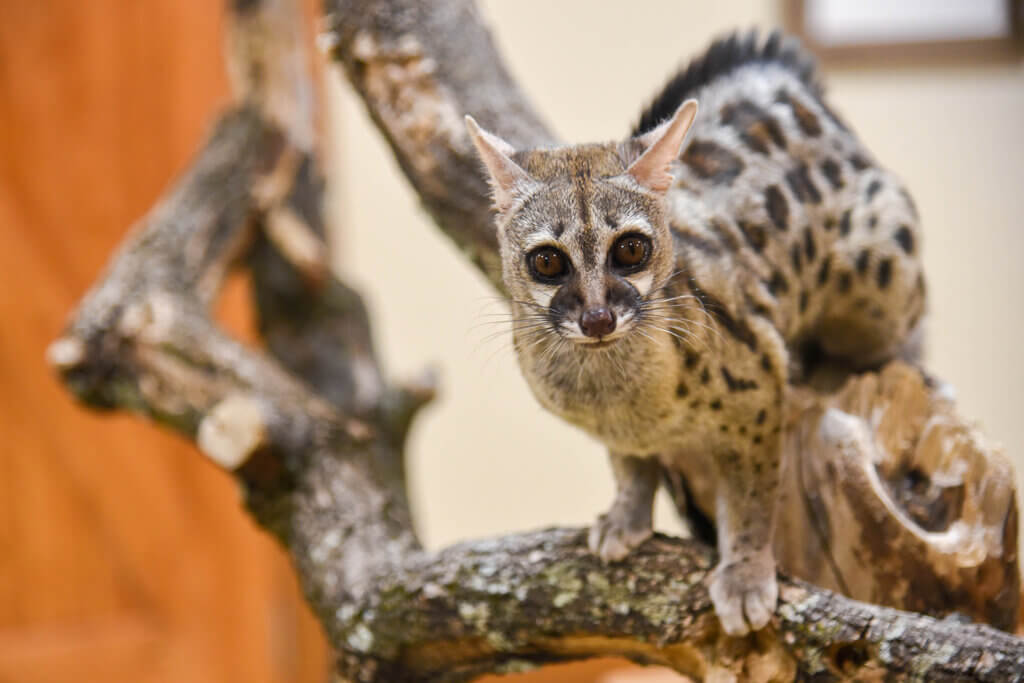Overview
“Where I live”
Cape genets inhabit savanna, shrub lands, and forests in countries of southern Africa. Considered highly adaptable, genets seem also to thrive in and around human settlements, including agricultural and urban areas.
“How I live there”
Genets have a diverse diet that changes seasonally. In summer, they eat mainly insects, while in winter, they tend to eat more small mammals, birds, reptiles, and amphibians. They have been observed eating some fruits and seeds.
“Making my mark”
Though catlike in appearance, genets are relatives of civets. Yet like many cat species, genets have the ability to retract their claws, allowing the claws to remain sharp. These highly skilled climbers are semi-arboreal. Their excellent binocular vision allows gents to judge distance effectively when moving through trees and pouncing on prey.
Cape genets rely heavily on scent for communication. They will scent mark using secretions from an anal gland. In particular, scents left at latrines at the edges of a genet’s territory convey important information to an approaching genet about the territory holder.
“What eats me”
Not much is known about the specific predators of this species of genet, but they have been reported as prey for large eagles.
Raising Young
Adult genets are primarily solitary. The exceptions are during breeding season or while a female is raising young. Breeding occurs during the warm season, which is September to March in their range. The male and female do not form a pair bond, and the male plays no role in caring for the young, After a pregnancy of about 3 months, the female gives birth to a litter of up to five cubs, keeping them protected in a roost contained in a thicket or tree. The young are weaned by the age of 11 weeks, and by the age of about 7 months, a young genet is able to take its own prey successfully.
Taxonomy
- Kingdom: Animalia
- Phylum: Chordata
- Subphylum: Vertebrata
- Class: Mammalia
- Order: Carnivora
- Family: Viverridae
- Genera: Genetta
- Species: tigrina
What is an Animal Ambassador?
The Maryland Zoo refers to its special collection of education program animals as “Animal Ambassadors.” The Zoo currently cares for more than 60 Animal Ambassadors, representing more than 40 species, both native and exotic. These animals are managed separately from the rest of the Zoo’s collection and cannot be seen on exhibit at the Zoo. However, many can be seen up close and personal on a rotating basis at Creature Encounters, the Zoo’s outdoor education center; at camp and school programs at the Zoo; as featured participants in community-based Outreach programs; and at special events on and off Zoo grounds.
Animal Ambassadors spend countless hours working with their human handlers, developing bonds of trust and communication that will allow them to appear in front of audiences large and small. They are not show animals. They behave naturally, focusing audiences’ attention on their natural behaviors and adaptations and giving living, breathing meaning to concepts and topics that students may be studying.
Animal Ambassadors travel all over the state of Maryland and beyond, and many also make local and national media appearances, educating about wildlife while representing the Zoo and its commitments to animal welfare and conservation.
What is The Animal Embassy?
The Animal Embassy at The Maryland Zoo is an off-exhibit area that is not open to the public. It is where the Zoo’s “Animal Ambassadors,” or education program animals, live. The Embassy is home to more than 60 individual animals representing more than 40 different species. It is staffed by its own dedicated group of keepers and volunteers and has both indoor and outdoor living space for the animals.

